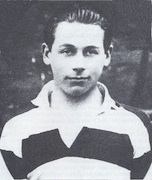
Kevin Barry, one of Ireland’s youngest martyrs, was born in Dublin on January 20, 1902, 110 years ago today.
He was the fourth of seven children. The Barrys came from a well-off family in Hacketstown, Co. Carlow. Carlow at that time was very nationalistic, so the Barry family brought this nationalistic sentiment with them to Dublin.
Kevin’s father ran a successful dairy business on Fleet Street in Dublin. This area today is part of Temple Bar which is a tourist area in Dublin. Kevin’s father died when Kevin was six years old and the family went back to the farm in Carlow. He went to school in Rathmines, Dublin and later attended Belvedere College where he excelled in rugby and hurling.
While at Belvedere Kevin joined the Irish Volunteers in 1917 at the age of 15 and+6, was in the C Company of the First Battalion. After the 1916 Rising, there was a major swing in Ireland towards nationalism and his family became involved in the national movement. One of Kevin’s early assignments was to deliver messages and orders, he would cycle all over Dublin in the course of his duties and became well acquainted with the city. He took part in a number of more serious operations including a raid on Marks in Chapel Street for ammunitions. His education did not suffer from his work with the Movement he won a scholarship to the National University Dublin, now University College Dublin and went in for the -study-of medicine.
In 1920 the War of Independence was raging in Ireland and Kevin was involved in a number of skirmishes with his Company; by this time he was a Section Commander. On June 1, 1920, Company C under the command of Peader Clancy in a daring raid on King’s Inn captured a large quantity of ammunitions and weapons. In another operation around the same time, Kevin led a group and raided the guard room on Constitutional Hill. More the 25 British soldiers were captured as well as arms and ammunition. The soldiers were later released unharmed.
On September 20, 1920 the Volunteers ambushed an army bread van on Queens Street near Monks bakery. The morning of the ambush, Kevin had been to Mass and was due to sit for his first-year medical exams that afternoon. According to British sources, in the ensuing gun battle a number of soldiers died in the ambush ranging in age from 15 to 23 years. According to Irish sources there has but one British fatality during the fight. The volunteers fled the scene as additional British forces arrived. Kevin Barry was captured while hiding under a lorry in the area.
He was interrogated and tortured by the British but refused to divulge the names of his Company. He was court-martialed and sentenced to death on October 20th. Several unsuccessful attempts to rescue him were made in the following days and all appeals on his behalf failed. Meanwhile in Cork, the Lord Mayor, Terence MacSwiney died from hunger strike generating huge world-wide publicity. He was buried in Cork on October 29, 1920. Most observers believed that the British would not go ahead with the execution of Kevin Barry in the midst of a tense political situation after MacSwiney’s death.
On the morning of November 1, 1920, at 8.30am, Kevin Barry was let to the gallows at Mountjoy Jail and hanged. He was buried in the yard of the jail. Between March and June 1921, nine more Irishmen were hanged in Mountjoy and were also buried in the jail yard. His was the first official execution since the executions following the 1916 Rising. There was widespread indignation across Europe and America at the execution of Kevin Barry due to his extreme youth. The British tried to justify the hanging by saying that one of the soldiers that died was younger than he was. His execution led to many of his fellow students joining the IRA.
Kevin Barry has been the topic of many Irish rebel songs. He is eulogized for his youth, but despite his youth he was an active fighter in the cause for Irish Freedom. He immediately became an icon for the Irish, not so much for what he did but for what had been done to him. He became another martyr for Irish Freedom.
![[Irish Republican News]](https://republican-news.org/graphics/title_gifs/rn.gif)
![[Irish Republican News]](https://republican-news.org/graphics/title_gifs/harp.gif)

